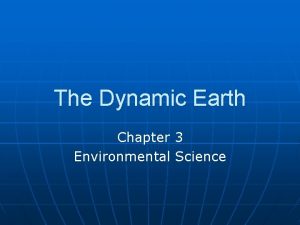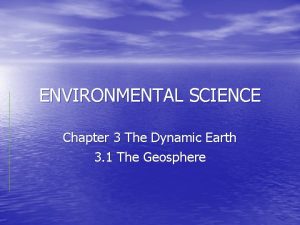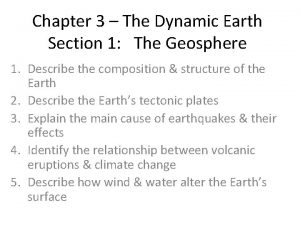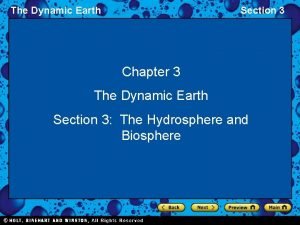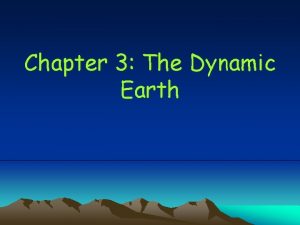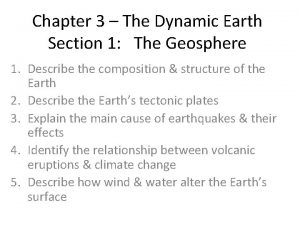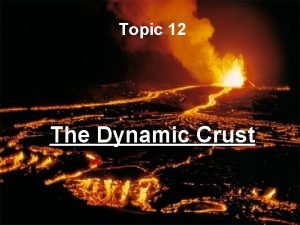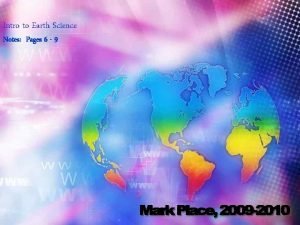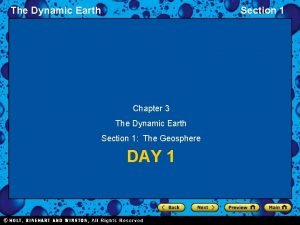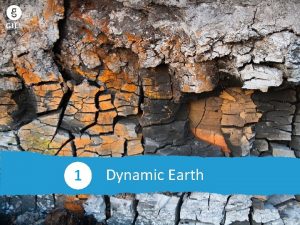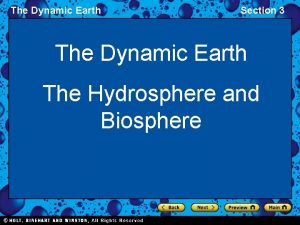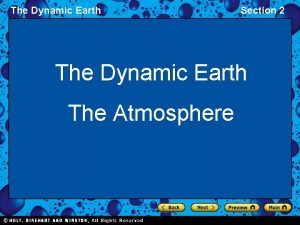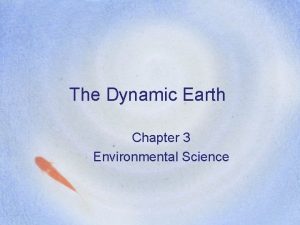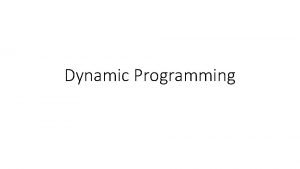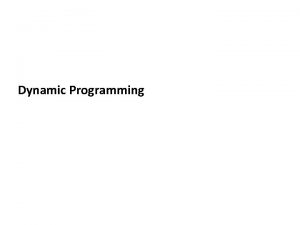CHAPTER 17 The Dynamic Earth Earth is composed










- Slides: 10

CHAPTER 17 The Dynamic Earth • Earth is composed of layers. • The three main layers are the crust, mantle, and core. • Earth’s outer layer has moved. • At one time, the continents formed Pangaea, a single huge landmass.

CHAPTER 17 The Dynamic Earth • Plates of the outer layer move continuously. • Plate tectonic theory explains the mechanisms by which tectonic plates move. • This movement explains Earth’s geological events and features, such as volcanoes and mountains.

CHAPTER 17 The Dynamic Earth Activity • Scientists use both direct and indirect observations/measurements to solve real-world problems. A direct measurement means you measure exactly what you mean to measure, while an indirect measurement measures one thing to get information about something else. • Try the following: 10 cm • Indirectly determine the area of one circle if the square is 10 cm by 10 cm. • Directly determine the area of one circle if you measured 10 cm 2 the radius to be 2. 5 cm (Area of a circle = 3. 14 r ). • What can you infer about direct and indirect measurements? Which is better? Is one more accurate? • Which type of measurement would you use to get information about • the weight of a car? • the size of an atom? • the temperature inside a freezer? • Find out how scientists use both direct and indirect observations and measurements to find out about Earth’s structure on pages 494– 495.

CHAPTER 17 The Dynamic Earth Key Ideas • Earth is composed of layers. • Earth’s outer layer has moved. • Plates of the outer layer move continuously. • This movement explains Earth’s geological features and events.

17. 1 Structure of Earth • Distinct properties define Earth’s three main layers: crust, mantle, and core. • The crust is the rigid outer layer that makes up the continents and sea floors. VOCABULARY crust mantle lithosphere asthenosphere • The lithosphere is a region formed by the crust and the rigid outer layer of the mantle. core • The asthenosphere is the fluid-like layer of mantle beneath the lithosphere. inner core • Earth’s centre has two layers: a liquid outer core and a solid inner core. outer core seismic wave

17. 1 Structure of Earth • Scientists obtain information about the structure of Earth through direct and indirect observations. • Direct observations include analyzing rock directly from Earth’s interior. • Indirect observations include measuring gravitational force differences around the globe to infer the density of material beneath Earth’s surface. VOCABULARY crust mantle lithosphere asthenosphere core outer core inner core seismic wave

17. 2 Evidence of a Dynamic Earth • The surface of Earth moves constantly. • The lithosphere is divided into massive tectonic plates that are pushed and pulled over the asthenosphere. • Continental drift theory argues that the continents have moved slowly since Earth formed. • Fossil and geological evidence support the continental drift theory. • At one time, the continents formed Pangaea, a single huge landmass. VOCABULARY tectonic plate continental drift theory paleoglaciation

17. 3 New Evidence of a Dynamic Earth • Sea-floor spreading occurs at mid-ocean ridges and subduction occurs at deep ocean trenches. VOCABULARY mid-ocean ridge sea-floor spreading ocean trench • Heat within Earth creates convection currents in the mantle that help move the plates. • Radioactive dating of core samples confirmed evidence that the sea floor is older the further it is from the ridges. • Magnetic striping patterns in sea floor rock are similar on both sides of an oceanic ridge, suggesting new ocean floor is being created at the ridge.

17. 4 Theory of Plate Tectonics • The theory of plate tectonics states that the lithosphere is divided into 12 large sections (plates) and about 20 smaller ones. VOCABULARY theory of plate tectonics divergent boundary rift valley convergent boundary subduction zone oceanic–oceanic convergent boundary oceanic–continental convergent boundary continental–continental convergent boundary transform boundary strike–slip fault

17. 4 Theory of Plate Tectonics • Three types of boundaries exist where tectonic plates meet. These create Earth’s geological features and events. • Ridges, rifts, volcanoes and earthquakes are created at divergent boundaries, where plates are moving away from each other. • Earthquakes and strike-slip faults are created along transform boundaries, where plates move past each other in opposite directions. • At convergent boundaries (where plates move toward each other), we find mountains, trenches, subduction zones, volcanoes, and earthquakes, depending on the types of plates involved. VOCABULARY theory of plate tectonics divergent boundary rift valley convergent boundary subduction zone oceanic–oceanic convergent boundary oceanic–continental convergent boundary continental–continental convergent boundary transform boundary strike–slip fault
 Chapter 3 the dynamic earth
Chapter 3 the dynamic earth Chapter 3 the dynamic earth
Chapter 3 the dynamic earth The dynamic earth chapter 3
The dynamic earth chapter 3 Chapter 3 the dynamic earth
Chapter 3 the dynamic earth Chapter 3 the dynamic earth section 1 the geosphere
Chapter 3 the dynamic earth section 1 the geosphere The dynamic earth chapter 3
The dynamic earth chapter 3 Dynamic dynamic - bloom
Dynamic dynamic - bloom Earth's dynamic crust and interior topic 12
Earth's dynamic crust and interior topic 12 Dynamic equilibrium earth science
Dynamic equilibrium earth science Dynamic earth structure
Dynamic earth structure Hình ảnh bộ gõ cơ thể búng tay
Hình ảnh bộ gõ cơ thể búng tay
